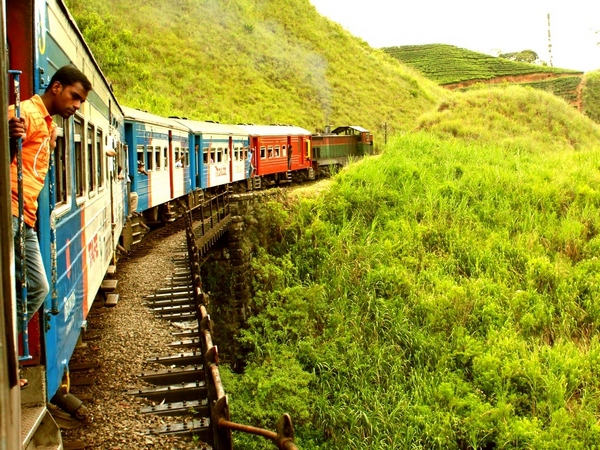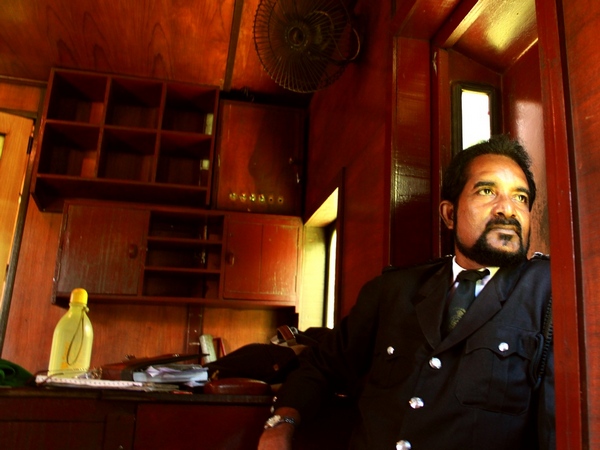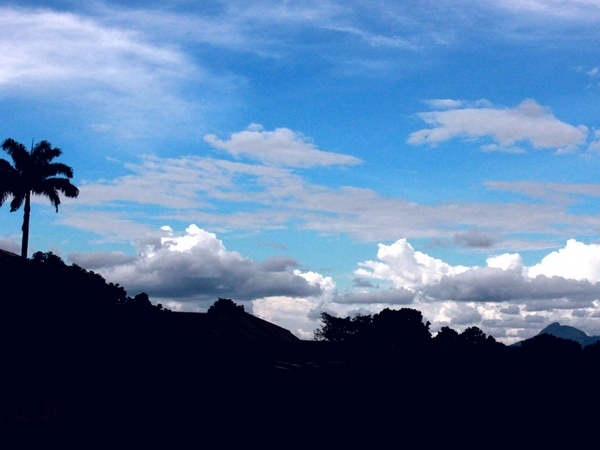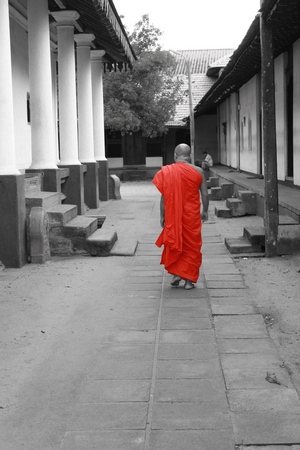
Yesterday, we posted the first in a three-part series of Abhishek Mande's travels to the island nation. Today we continue where we left off from.
According to our initial travel plans, we were to spend a night each in Hikkaduwa, Galle and p-e-r-h-a-p-s Bentota but since we were quite happy with the guesthouse in Hikka and also because we figured we could cover Galle and Bentota in a day trip, we decided to make Hikkaduwa our base and travel to the two places. We didn't do much in Hikkaduwa itself except exploring the village, trying out some of the local cuisine and of course exploring the lagoon.
Bentota lies to the north of Hikkaduwa and is far more exclusive than the hippytown Hikka thanks to its quieter beaches and a presence of five star hotels (including our very own Taj).
En route to Bentota, two places of interest that we stopped by at were Ambalangoda and Kosgoda.
Ambalangoda is the centre of Sri Lanka's mask-making industry and houses numerous shops factories that make traditional Sri Lankan masks. Ariyapala and Sons Mask Museum is the most popular one there.
Named after and set up by the sons of mask carver Ariyapala Wijesuriya, the museum is a must-visit. Ambalangoda is also where you can buy all the traditional masks your heart desires. But where Ambalangoda scores in variety, it loses in pricing. We found that though there were fewer masks in Hikkaduwa, they were also considerably cheaper. In any case, a couple of hours at either town could solve all your return-gift worries.
While buying a mask, make sure you know what it signifies. Even though most masks are meant to be hung inside the house, some are supposed to be displayed only outside your main door and every mask has a purpose -- from finding peace and friendship to gaining popularity and driving away evil spirits.
***
There are a number of turtle hatcheries along the beach between Induruwa and Ahungalla. Yohaan, who runs the guesthouse we were staying at in Hikkaduwa suggested we visit the one right behind the Kosgoda Police Station.
The hatchery that gathers and hatches turtle eggs, also breeds and nurtures young turtles before sending them out into the sea. It also nurses the injured ones and is home to a rare albino turtle too.
It will cost you LKR 500 per head for a trip that won't last more than 30 minutes but you can take heart from the fact that (at least most of ) it goes towards a noble cause.
If you're really into turtles and immensely patient, you can also participate in turtle watches by accompanying the locals to the beach in the night. However it would be advisable to check in advance if the programmes are running.
We didn't spend a lot of time in Bentota itself, choosing rather to lounge on the beach for a few hours before heading back to Hikka.
On our way back we discovered a charming church converted into a Buddhist temple. On the inside, larger-than-life Buddha statues stood alongside life-size models depicting scenes from his life. (Sadly, I managed to misplace my notes along the way so I'll never know what it's called or its exact location. It is however about 5-10km from Bentota towards Hikkaduwa on your left.)

Reaching Kandy from Hikkaduwa can be trickier than you expect. There is just one direct train to Kandy from Hikkaduwa leaving around 3.30 pm and taking about 5-6 hours to reach its destination. Unless you don't mind wasting a day, it is more advisable to travel to Colombo and then take another train from there. Alight at Peradeniya Junction about 6km before Kandy from where another connecting train will take you to the hill station. You have to purchase two tickets at two stations -- the first one from Hikkaduwa to Colombo Fort and the second from there to Kandy.
The train we took from Hikkaduwa to Colombo ran almost along the sea in its final 10km run and had swanky and well-maintained Chennai-made coaches with cushioned chairs that were brightly light and well-ventilated making us wonder why India never seemed to get some of those.
Colombo to Kandy is a far more picturesque journey though and if you're absolutely certain about your itinerary, ensure you buy a first class or an 'observation van' ticket. These tickets are few in number and are sold out almost on the same day as the bookings open few weeks before the train's departure date. The observation van is the last car in the train and offers panoramic views of the landscape. If you're travelling second or third class, ensure you sit on the left hand side to get the best views to Kandy.
At Colombo Fort, we had a couple of hours to kill and since we'd left at around 5am from our hotel we decided to grab some breakfast at a local joint across the road from the station.

In many ways, Sri Lanka is an incredibly clean country by (pardon the expression) third world standards. During the 12-odd days we spent there, we didn't spot a single overflowing garbage bin or people standing by the road to urinate or generally littering the streets.
By those standards, the budget eateries made a terrible impression. It seemed to us that there were only two kinds of restaurants in Sri Lanka -- the five-star joints that were clinically clean or the roadside eateries that though served good food left a lot to be desired on the cleanliness front. Sure there were KFCs and McDonalds' restaurants but we found it difficult to locate a mid-level restaurant.
In India, one of running jokes this side of Vindhyas about Tamilians relates to their obsession with having thayir sadam or curd rice at every meal. Even though I find that a bit far stretched and even racist to some extent, I suspect a variation of it might hold true for Sri Lankans who love their curry-rice with a vengeance.
Irrespective of the time of the day we entered any restaurant, rice and curry always seemed to be on the top of the menu. Sure there were 'short-eats' (such as mutton rolls and patties) but are few things that come close to Sri Lankans and their love for curries.
The other learning was that Sri Lankans have just one standard portion for all meals -- large. So, invariably we ended up ordering just one portion that would not just suffice the two of us but would almost always go waste.
Chinese fried rice seemed to be another popular dish amongst Sri Lankans and is very close to the kind of Chinese we love to eat here in India.
Kotthu roti, the most famous of Sri Lankan exports however seemed to be more of a dinner dish and couldn't seem to find a place that served it for breakfast or lunch. It was also a dish I warmed up to almost immediately (though my girlfriend who'd had it in various Sri Lankan eateries in Canada didn't seem too impressed with its authentic version).
At Colombo Fort station we didn't have a lot of choices for eateries and so we picked the only one that was open at the hour. After a sumptuous breakfast of -- you guessed it --curry-rice we headed back to the train station.
Like almost all other trains, the one heading to Kandy also ran on diesel (there is a steam locomotive but it is reserved for Viceroy Special, the luxury heritage train similar to Maharashtra's Deccan Odyssey and Rajasthan's Palace on Wheels) and seemed to have been inducted into service in the 70s (and never been serviced since). The shock absorbers looked as if they were non-existent leading to a great deal of discomfort in spite of the relatively comfortable seats.
To give credit where it's due, the train wasn't littered and though I kept reaching out to my sanitiser bottle, I was aware there were far more unclean trains in India that I'd travelled on.
The journey to Kandy is charming but somewhat long, especially if you've woken up at 4am to reach Colombo in the first place. If, like us, you've stayed at one of the beach destinations such as Bentota or Hikkaduwa, it might not be such a bad idea to break your journey at Colombo, spend a couple of days in the capital and then head inland. If however you're staying at Galle, there are regular bus services to the hill country towns such as Kandy and Nuwara Eliya.

Kanna hobbles into the area that passes off as the reception-cum-lobby of Lakshmi Guest House in Kandy.
Located at the top of Saranankara Road, this budget accommodation provides stunning views of Kandy and its surrounding hills. None of the rooms however offer that view -- all of them face the other side -- though you can trust Kanna to hard sell the 'valley view cafe'.
Nevertheless it is a charming little place and if you're looking for a place to just dump your bags and spend the night, this one is right up the alley.
Saranankara Road is where most budget accommodations are located and is less than 2km from Kandy railway station but a tuk tuk to reach there will set you back by a cool LKR 200; so be prepared. (Like in Hikkaduwa you can rent out bikes but at cost of LKR 2500 per day. There is by any standards just one dealer in Kandy called Malik, which should explain the steep price.)
After some haggling, Kanna agrees to let us stay there for LKR 1500 per night. We were to learn early on in our trip that most prices do not include a 10 per cent service tax. Kanna however assured us his price was all inclusive. We shook hands, dumped our bags and crashed out. We'd been travelling for about 7 hours now and thought a catnap wouldn't do any harm.
When we woke up however, it was close to 4pm and for what it was worth the day was wasted. However, it was not such a bad thing after all. We spent the rest of it walking in Kandy, which quite evidently livens up during the weekends. It was a pleasant break from the sleepy, non-happening villages and towns we were used to seeing.
College students walking down the street, young families shopping and the general festive air came as a refreshing change.
Sri Dalada Veediya or Sri Dalada Road is the main street of Kandy that houses a number of eateries including the charming Bake House as well as Hotel Devon among others.
Walk down Yatinuwara Veediya that runs perpendicular to Dalada Veediya for some more Sri Lankan options.
If you're craving some dosas, drop by at Balaji Dosas along DS Senanayake Veediya (that runs parallel to Yatinuwara Veediya) and serves, well, dosas as also Saumiya Cafe that essentially serves Sri Lankan cuisine but manages to whip out some mean masala dosas too.

At the centre of Kandy stands a huge manmade lake that was constructed by Sri Wickrama Rajasinha in 1807. The lake replaced the paddy fields which stood there once and was thought of by many as the king's extravagance. Those who resisted working on this seemingly pointless project were impaled on stakes on the lake bed.
The lake was built nonetheless and artificial island that stands at its centre was the king's harem. Later during the British regime they turned it into an ammunition store.
Even so, today it has become Kandy's most defining landmarks and around which the city runs and its leafy banks providing enough and more corners for snogging couples. If you wish to take a ride in the lake you can rent a boat from Joy Motor Boat Service that seems to be the only one offering rides of the kind.
The serene and beautiful Malwatta Monastery stands smack opposite the Temple of the Tooth across the lake. Visit it if you can just so sit around and meditate, though there aren't a lot of 'touristy' things to see in there.

Athula Mannapperuma has queued up with his family. His mother carries a plate of lotuses with reverence even as his two sons play around mischievously. The wife and he are in deep conversation while her sisters wait patiently for the doors of the Relic Room to open.
Mannapperuma has been visiting the Temple of the Tooth in Kandy for as long as he can remember. He says he's seen the tooth relic on his 15th birthday, a gift that could never be matched since.
He isn't the only one waiting outside the Relic Room. There are hundreds like him -- the numbers swelling during auspicious days -- including many tourists, some we recognise having met the previous day.
It wouldn't be unfair to say that Kandy would have probably been nothing had it not been for the Temple of the Tooth.
Said to house a tooth relic of the lord Buddha, the temple could have well been the reason why the economy of Kandy flourished in the initial years even though today it has emerged as the second largest city in the island with many corporations having large branch offices there.
The story of the Temple of the Tooth is perhaps one of the most fascinating ones that starts with an Orissan princess smuggling Buddha's tooth from Kushinagar in India after he was cremated in 543 BC to Anuradhapura in Sri Lanka.
There are various versions to the story one of which claims that the tooth that once fell into the hands of the Portuguese who destroyed it, magically came back together and flew all the way into Sri Lanka.
One of the versions of the story, long and convoluted to narrate in this article, is available here.
Even though the temple is open from 6am to 8pm every day, the room of the tooth relic is opened only thrice during which the relic is worshipped -- at 6am, 9am and 6.30pm. The last puja of the day is said to be the most elaborate of the three and one which we attended.
Do not however expect to see the tooth itself because it remains concealed under a golden cone (of which too you can catch only a glimpse as you file past it), revealed only a couple of times every ten years or so.
Remember that foreigners are required to pay a fee to enter the temple, though it is half for SAARC nationals. So remember to carry your passports. The ticket allows you entry to the Raja Tusker Museum, Audience Hall and the Sri Dalada Museum, the last of which we were too late to visit.
A separate ticket is required for the National museum that stands nearby which again was closed by the time we reached there.
In many ways Kandy was turning out to be the most interesting places in Sri Lanka. With a cosmopolitan culture and friendly locals Kandy reminded us of Mumbai. It would however be a while before we'd visit Mumbai's closest cousin, Colombo.